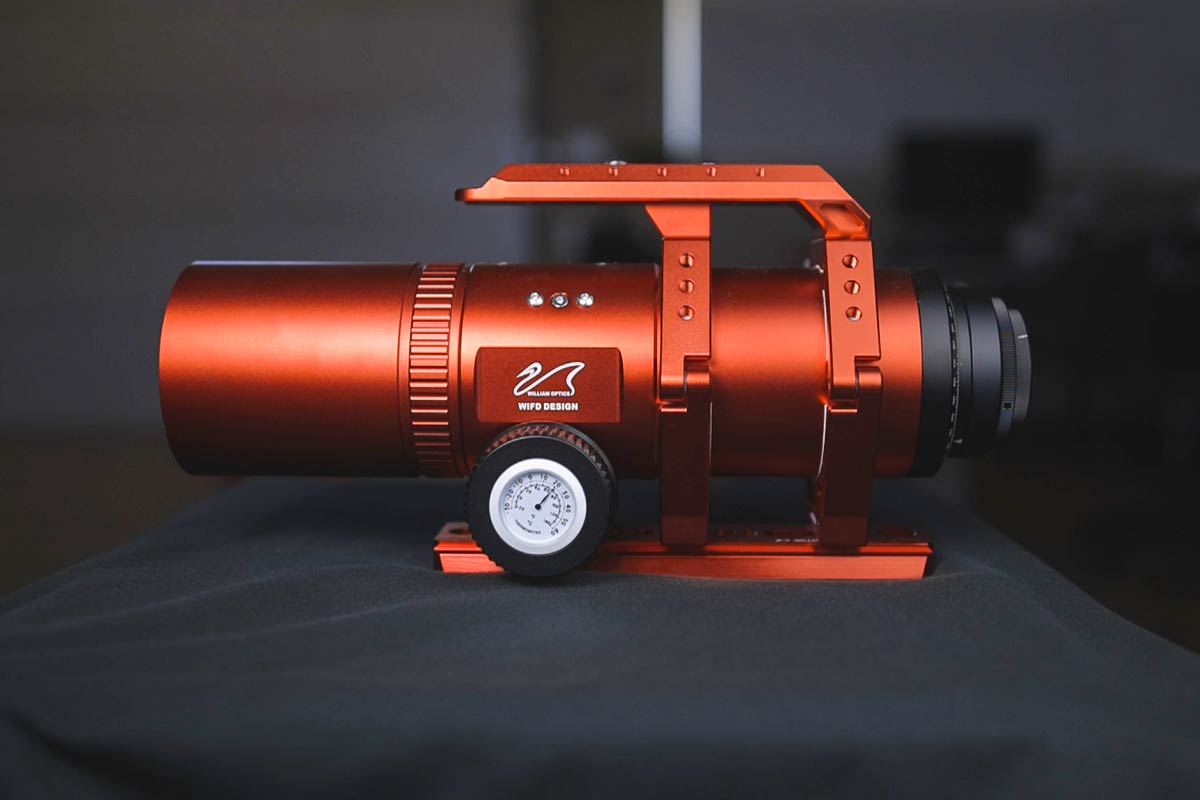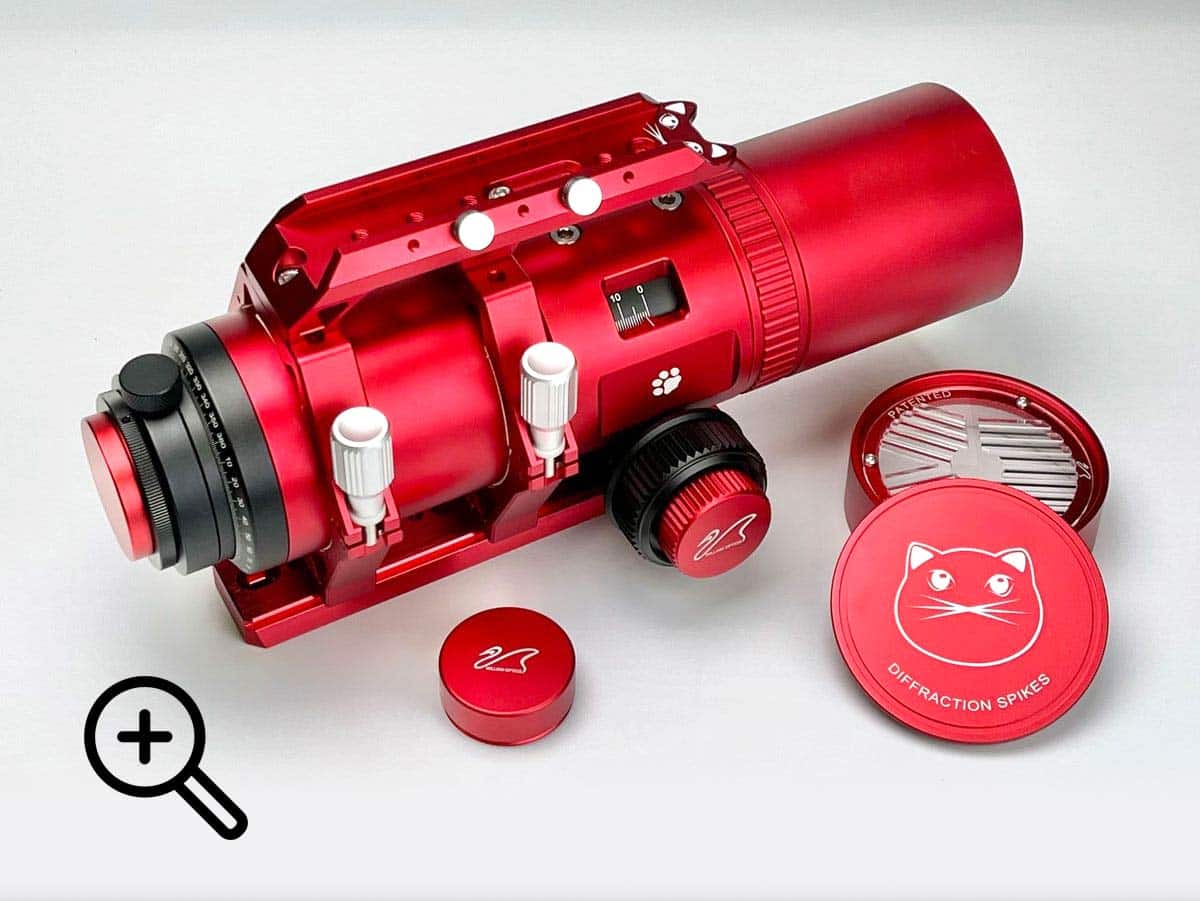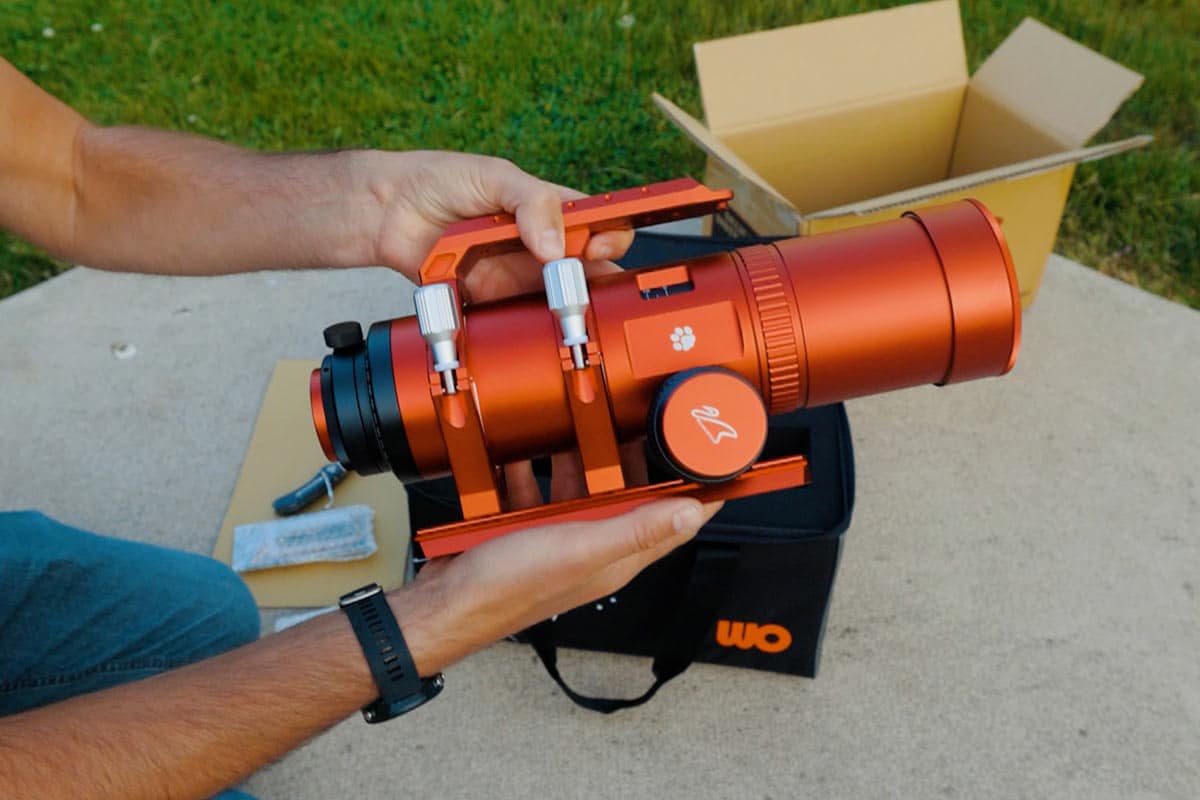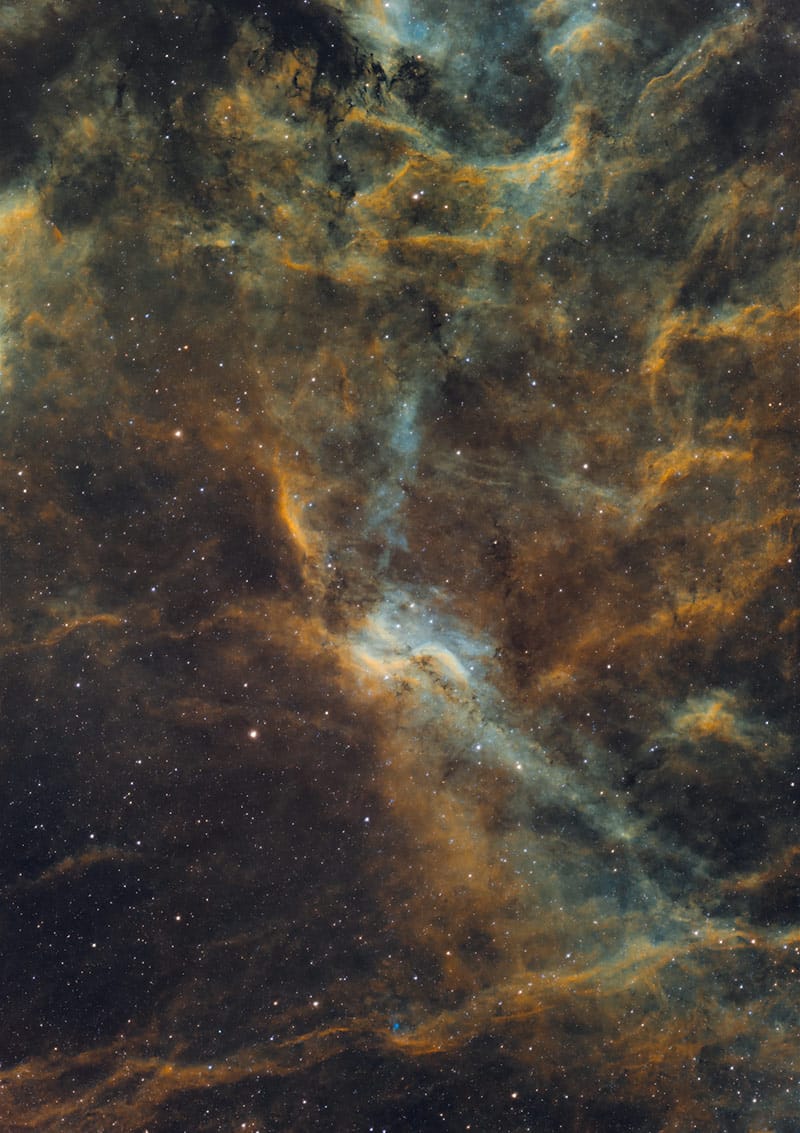[ad_1]
William Optics has introduced their third variation of the original RedCat Petzval Astrograph, the William Optics RedCat 61.
It’s small, it’s mighty, and it’s REDDER than ever. There’s also a huge change to this version of the RedCat when compared to the RedCat 51 and RedCat 71.
Like most reviews/first lights, I do my best to cover everything you need to know about this telescope before buying it while also capturing a beautiful deep-sky object to show you what it can do.
I have not been compensated for a positive review, nor does the company have any say in my review. It’s a ‘play with it and let us know what you think’ kind of deal.
William Optics RedCat 61
The RedCat 61 has a focal length of 300mm and a focal ratio of F/4.9. This means it is best used for wide-field nebulae projects and only the biggest galaxies. The moon is also in play, but planets are just too small for this scope.
Like the RedCats before it, the 61 uses FPL-53 glass in a Petzval lens design.
You can attach your full-frame DSLR, mirrorless, or dedicated astronomy camera to the T-mount and enjoy a 46mm image circle.
The William Optics RedCat 61 is Available at Agena Astro.
In the past, when using a full-frame camera, I’ve had to crop about 5% of the frame away using the RedCats. I expect to do the same with this one.
The scope weighs just 7.5 pounds, and you can likely tack on another 3-4 pounds for camera gear. This places the RedCat 61 in the small equatorial mount category or even on a well-balanced star tracker setup like the Star Adventurer or GTI.
The new internal focus design on the RedCat 61 (WIFD).
The biggest change to this Cat is one that I think will make people who may have ignored the first version take notice. The helical focuser is gone, and it now uses the patented WIFD internal focus design.
You know what that means – you can now use a traditional autofocuser with this scope, like the popular EAF. This internal focuser design is also available on the latest GT 81 APO, and I think William realizes he has a winner with this one.
William Optics RedCat 61 Specifications
Let’s have a look at the core specs of this refractor telescope.
- Focal Length: 300mm
- Diameter: 61mm
- Aperture: f/4.9
- Image circle: 46mm FF
- Flattener: Petzval Flat Field
- Focuser: Internal Focus Design
- OTA Weight: 5.43lbs / 2.465kg
- Total Weight: 7.47lbs / 3.390kg
What’s Included in the Box?
In terms of overall presentation and attention to detail, all of the William Optics stuff is really slick. It always includes a stitched, padded bag and certificate of inspection.
Included with the RedCat 61 are the red tube rings, a cat series handlebar for attaching other accessories, and a dovetail bar. Like most other William Optics telescopes, a dew shield cover and patented built-in Bahtinov mask are also included.
What Comes with the RedCat 61:
- Stitched and padded carry bag
- Tube Rings
- Cat Handlebar
- Dovetail bar
- Built-in dew shield
- Built-in Bahtinov mask
The Set Up
As you can see, it’s RED overload here on the ZWO AM5 mount – some may say it’s even TOO red.
My Astrophotography Setup featuring the RedCat 61.
In terms of mounting, a GoTo mount in the 20-30 lb payload range is more than enough. I’m sure the AM5 will be a popular choice if you plan on traveling with the rig.
Sticking with the lightweight motif, you can see the tiny 32mm guide scope I’ve mounted to the cat saddle. You can pick up an ASI120MM Mini and a little guide scope like this for about $250 (all in).
I’m a big fan of ultra-portable setups like this, but make no mistake, a configuration like this is best for capturing WIDE field images. If you want to go deeper, you’ll need a longer focal length.
I used the ASIAIR Plus to run the camera, which is an ASI2600MM Pro with an electronic filter wheel in front. With this camera – I get an image scale of about 2.5 arc seconds per pixel. This may be a little crispy (i.e. pixely, boxy, stars) for some, but overall it’s pretty well matched.
I would suggest not obsessing over image scale because a lot of these ‘rules’ don’t mean a whole lot after you apply techniques like BlurXterminator afterward anyway.
Because of its compact size, I am looking forward to testing it out with my full-frame mirrorless camera in the future as well. The threaded M48 connection at the back of the scope couldn’t be easier, and with no additional flattener or reducer needed the correct backspacing at this connection is ready to go.
Astrophotography Results with the RedCat 61
To all the people that accuse me of shooting the same targets over and over again, I am happy to inform you that I went after something a little more obscure with this telescope.
Just north of the star Sadr lies a collection of sinewy ribbons of hydrogen gas and a fascinating object known as the Propeller Nebula. After over a decade of shooting, I have never attempted to photograph this nebula before!
This is what a stack of images looks like in Ha, OIII, and SII with the RedCat 61. Everything looks as it should in terms of optics – but as I said, narrowband imaging doesn’t exactly scrutinize a scope.
I shot this target in narrowband due to a bright, 82% illuminated Moon. The seeing conditions during this image were not great and I was shooting through high clouds for a while.
If we combine the narrowband image stacks together into RGB channels, you get a little something like this.
The Propeller Nebula in Cygnus. 3 Hours Total Exposure.
Image Details:
- 15 x 4-minutes (H-Alpha)
- 15 x 4-minutes (SII)
- 15 x 4-minutes (OIII)
The images were registered and calibrated in DeepSkyStacker, and processed in Adobe Photoshop and PixInsight. For a better understanding of the way I process my astrophotography images, feel free to check out my premium image processing guide.
To test the color correction of the scope, I’ll need to collect some broadband images. You can expect to see those added to this article as soon as I get the RedCat 61 under a moonless sky.
Differences Between RedCats
Here is a table showing the differences between the three generations of RedCat telescopes.
| RedCat 51 | RedCat 61 | RedCat 71 | |
|---|---|---|---|
| Aperture | 51mm | 61mm | 71mm |
| Focal Length | 250mm | 300mm | 348mm |
| Focal Ratio | f/4.9 | f/4.9 | f/4.9 |
| Optical Design | Petzval Refractor | Petzval Refractor | Petzval Refractor |
| Weight (OTA with ring, dovetail and saddle) | 3.9 lbs / 1.76 kg | 7.47lbs / 3.390kg | 8.2lbs / 3.7kg |
| Tube Length (fully extended) | 291mm | 365mm | 435mm |
| Image Circle | 43mm | 46mm FF | 45mm |
| Focuser | Manual Helical focuser | WIFD (WO Internal Focus Design) | Helical Focuser with 2GT Gear Ring |
| Field of View | 4.88° x 3.25° (with APS-C camera) | 4.88° x 3.25° (with APS-C camera) | 4.88° x 3.25° (with APS-C camera) |
| Approximate Price (USD) | $865 | $1,598 | $1,698 |
Unlike when the original RedCat 51 came out in 2019, there are several telescope options to choose from at this focal length.
With the introduction of the internal focuser, it seems like William is moving away from the ‘is it a telescope or a lens’ idea, and doubling down on the idea of an astrophotographic-specific Petzval APO refractor.
I personally experienced some slight issues with TILT on the previous Redcats, but to be fair, I didn’t really have the right tools or know-how to properly identify and adjust them. They did come with a tilt adjuster, but it was a hard thing to get just right.
I have a feeling that a big part of the new focuser design will address this issue, I will have to use it more to find out for sure.
Final Thoughts
The William Optics RedCat 61 is a premium astrograph with high-end optics. There are no additional field flatteners or reducers needed for optimum performance.
It has a huge image circle and rotator, the types of things you have come to expect from the Cat series of telescopes.
The internal focuser was a good call, and you can now use a standard autofocuser. The WIFD design means you’re not extending the imaging train to reach focus, which is a nice change for those of us who are used to a long imaging train.
One issue I had with the RedCat 61, so far, was the size of the huge focuser knob, and its central position on the telescope. It runs into the mounting plate on the AM5.
To fix this, I had to move the scope up a bit, but at first, I couldn’t understand why the focuser wouldn’t move. Not technically an issue – more of something to keep in mind
The other thing to consider is, of course, the cost. It is currently $1600 USD, and for a 61mm telescope, that’s pretty steep. However, you save the cost of a corrector and it comes with a bag, dovetail to mount a guide scope, and Bahtinov mask.
I think there is a huge market for this telescope. I think it has to potential to outsell the original RedCat 51, which would really be something.
There’s definitely a goldy-locks vibe to the 61. The 51 was impressive and small, the 71 had more reach but kept the helical focuser but this one gets just about everything right.
Related Content:
[ad_2]






